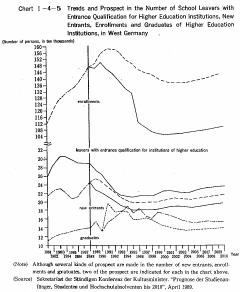| Home > Policy > White Paper, Notice, Announcement > White Paper > JAPAMESE GOVERNMENT POLICIES IN EDUCATION,SCIENCE AND CULTURE 1990 > PART |
||
Institutions of higher education in West Germany, which have expanded since the beginning of the 1960's, may be classified into two categories: universities and Fachhochschulen.
Universities include technical universities, teacher training colleges (Padagogische Hochschulen) and colleges of arts and music (Kunsthochschulen, Musikhochschulen). Universities are core institutions in the whole higher education system in West Germany. Some of them date back to the medieval age and some others are new ones created in and after the 1960's with the aim of helping increase the number of university places and remedy the regional imbalance in university availability.
Fachhochschulen are institutions of higher education created on the basis of the re organization of former Ingenieurschukn (schools of engineers) etc. Whi1e academic institutions place emphasis on basic research, Fachhochschulen stress education related to the application of theories. They offer courses of engineering, economics, social welfare and other various fields. The length of courses in these institutions is usually three years, shorter than that of university courses. Most Fachhochschulen offer courses in two or more fields of study and most of them enroll not more than 3,000 students.
The number of students enrolled in institutions of higher education was only 250,000 in 1960 (accounting for 4% of the population aged 19 to 26). Since then it continued to increase year-by-year and reached 1,370,000 by 1986. (This number a counted for 18% of the population aged 19 to 26 in the same year.) Of this total, 1,050,000 were enrolled in universities and 310,000 in Fachhochschulen. This expansion of higher education enrollment was brought about partly by the government policies for making higher education available to more students who wish to go onto higher education and partly by the growing demands of parents and students for higher education. An analysis of the percentage distribution of higher education students by age range indicates that 17.O% of them is between the ages of 18 and 22,33.4% between the ages of 22 and 25,19.0% between the ages of 25 and 27, and 30.6% aged 27 or more. Students in a higher age group make up a relatively high percentage.
According to a projection made in the early 1980's, the number of higher education students was anticipated to begin to decrease in the early 199O's on the basis of the past trend in birthrates. In spite of this projection, however, the number of higher education students will not begin to decrease in the early 1990's. One of the most serious problems faced by institutions of higher education is the deterioration of physical and other conditions of educational and research activities due to the fact that these institutions now enroll as many as 1,400,000 students, although the total number of student places is less than 900,000. In addition, in the context of the rapid progress of reunification of West and East Germany since the opening of the Berlin Wall in November 1989, it is anticipated that a large number of students in East Germany will wish to study in West Germany. The current serious situation in higher education will continue at least for several years a head due to the influx of students from East Germany.

While facing an increase in higher education enrollment, the Federal Government has defined it as the most important issue in educational policy to help individual institutions make clear their own distinctive characteristics and improve their educational and research activities through active competition with other institutions. Among the other issues is how to reduce the number of years of students' enrollment in institutions. The Federal Government has also provided special financial assistance to some institutions to facilitate an increase in the number of student places for business administration, information science and other certain courses for which there is a high social demand. This assistance also aims at helping to improve the physical and other conditions of these courses.
| Back to Top | MEXT HOME |